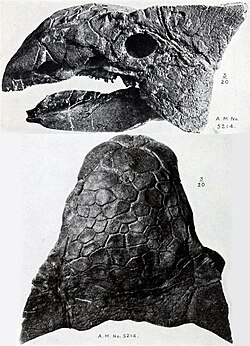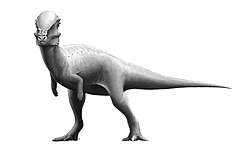Top Qs
Timeline
Chat
Perspective
Scollard Formation
Geologic formation in Alberta, Canada From Wikipedia, the free encyclopedia
Remove ads
The Scollard Formation is an Upper Cretaceous to lower Palaeocene stratigraphic unit of the Western Canada Sedimentary Basin in southwestern Alberta.[1][3] Its deposition spanned the time interval from latest Cretaceous to early Paleocene, and it includes sediments that were deposited before, during, and after the Cretaceous-Paleogene (K-Pg) extinction event. It is significant for its fossil record, and it includes the economically important coal deposits of the Ardley coal zone.
Remove ads
Lithology
The Scollard Formation consists primarily of sandstones and siltstones, interbedded with mudstones and, in the upper portion, coal seams, as well as minor amounts of bentonite.[1] The sediments were eroded from the Canadian Cordillera, and were transported eastward by river systems and deposited in fluvial channel and floodplain environments.
Stratigraphy
Summarize
Perspective
The Scollard is usually classified as the uppermost formation of the Edmonton Group, although some early workers included it in the overlying Paskapoo Formation.[4] It is subdivided into an upper, coal-bearing member that consists of the Ardley coal zone, and a lower member that lacks significant coal.[1] Neither member has been formally named.
Age

The K-Pg boundary occurs at the base of the lowermost seam of Ardley coal zone, based on dinosaurian and microfloral evidence,[5] as well as the presence of the terminal Cretaceous iridium anomaly.[6] The upper member is therefore of early Danian age, while the lower member is of latest Maastrichtian age.
Distribution
The Scollard Formation is present in the subsurface throughout much of southwestern Alberta,[7] and it outcrops extensively along the banks of the Red Deer River in the area of Trochu.[8] Both the upper and lower members thin from west to east. Thicknesses for each member range from more than 300 metres (980 ft) near the foothills of the Canadian Rockies to less than 100 metres (330 ft) near the outcrops in south-central Alberta.[1]
Relationship to other units
The Scollard Formation rests disconformably on the Late Cretaceous Battle Formation in the southwestern Alberta plains, on the Wapiti Formation in the northwestern plains, and on the Brazeau Formation in the foothills. It is unconformably overlain by the Paskapoo Formation, and where the Paskapoo has been removed by erosion, the Scollard is exposed at surface or covered by Quaternary sediments.
The Scollard grades into the Willow Creek Formation in the southern Alberta plains and the Coalspur Formation in the Alberta foothills. The Ardley coal zone in the upper portion is equivalent to the lower part of the Coalspur coal zone of the Coalspur Formation,[9] and is correlated with the lower part of the Ravenscrag Formation of southern Saskatchewan, which is also coal bearing.[10] The Late Cretaceous member is equivalent in age to the Frenchman Formation of Saskatchewan, the Hell Creek Formation of Montana, and the Lance Formation of Wyoming .[1]
Remove ads
Coal deposits

The coal seams of the Ardley coal zone attain thicknesses in excess of 7 metres (20 ft) in some areas. The zone is present at shallow depths and, in places, exposed at surface, along a trend between Red Deer and Edmonton. The coal is typically of sub-bituminous B to C rank, although more deeply buried Scollard coals farther to the west reach high-volatile bituminous rank. The Ardley coal has been mined in the Red Deer area, and is currently being mined west of Edmonton to fuel mine-mouth electric power generating stations.[11]
Paleontology
Summarize
Perspective
The Scollard Formation preserves the remains of vertebrates, especially dinosaurs and, rarely, mammals, as well as a wide range of plant fossils. The Scollard strata span the K-Pg boundary, therefore the lower member of the Scollard provides a record of the last of the dinosaurs, while the upper member records the dawn of the Age of Mammals after the K-Pg extinction event.
Flora
Plant fossils from the upper, early Paleocene member of the Scollard Formation include species of the ferns Botrychium, Woodwardia and Azolla; the conifers Metasequoia and Glyptostrobus; the monocot Limnobiophyllum (a relative of duckweeds), Sabalites geneseensis (similar to Serenoa repens); and the dicots Cercidiphyllum and Platanus. Leaf analysis of the Genesee flora estimated mean annual temperature at 11 °C (52 °F) with a cold month mean temperature of 2.4 °C (36.3 °F).[12][13][14] Graminidites, a Grass palynomorph occurs in the Maastrichtian Scollard Formation. The species, G. ulkapites, occurs at the initiation of a temperate climate in the area.[15]
Vertebrates
Crocodylian Albertosuchus, acanthomorph fish Lindoeichthys and unnamed esocid fish are known.[16][17][18]
Theropods
Ornithomimus remains have been unearthed here.[19] Two caenagnathid taxa, a large-bodied one similar to Caenagnathus and a small-bodied one similar to Leptorhynchos have been found.[20]
Ornithischians
Fossil remains of the nodosaur Edmontonia and the chasmosaur Torosaurus have also been unearthed here and in the nearby areas.[19][27]
Color key
|
Notes Uncertain or tentative taxa are in small text; |
Remove ads
See also
References
Wikiwand - on
Seamless Wikipedia browsing. On steroids.
Remove ads













